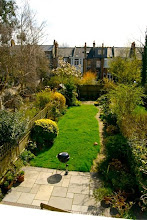

Thanks to everyone for sweet birthday wishes and lemony messages. It was a perfect English midsummer's day, the roses in my garden all bursting into flower at once. There was tea and champagne and a Victoria sponge cake from my younger son (filled with jam and cream), and other treats -- a pot of lavender from a friend, three new rosebushes from my mother, a pair of earrings (delicate gold and mother-of-pearl), and some wonderful books: including a recent edition of Sappho, Stung with Love (Poems and Fragments), with a preface by Carol Ann Duffy. The translation is by Aaron Poochigian -- a musical, lilting interpretation, like this one, from a fragment discovered on a broken piece of pottery:
'... roses without number
Umber the earth and, rustling,
The leaves drip slumber.'
Duffy writes of Sappho: 'She was a great celebrator, had a poet's and a woman's eye for the 'gorgeous'; for flowers -- chervil, rose, marigold and sweet clover; for smells -- frankincense, aniseed, myrrh and honey; she loved the moon and 'The glitter and glamour of the sun'; she loved... a good party, 'a gleaming feast'.
Yesterday evening, I visited a friend; we sat with two others on her roof terrace, high above dusty London pavements, close to the top of the plane trees, eating cherries soused in grappa, with homemade meringues and ginger icecream. We talked of heartbreak and romance, of the differences between men and women, of the fragile threads that weave into something whole.
Now the waxing moon rises beyond the magnolia tree at the end of the garden. I have just been outside in the warm darkness, watering the roses, counting my blessings, wishing that the petals would never fall, seeing them drop, pale and beautiful, to the ground, knowing that other buds will take their place; hoping that this moment, this one that now hovers, might stay with me always, wishing again that this one... and that one... could remain unfaded, even as the years turn, as they must do; unbroken, as clear as a word on a page.


















